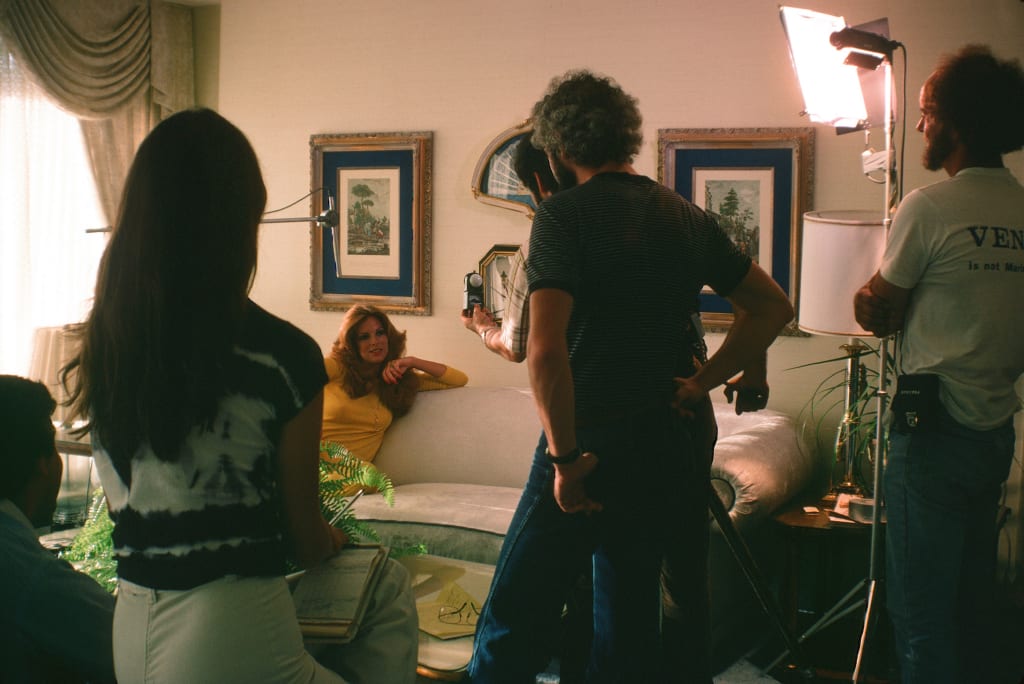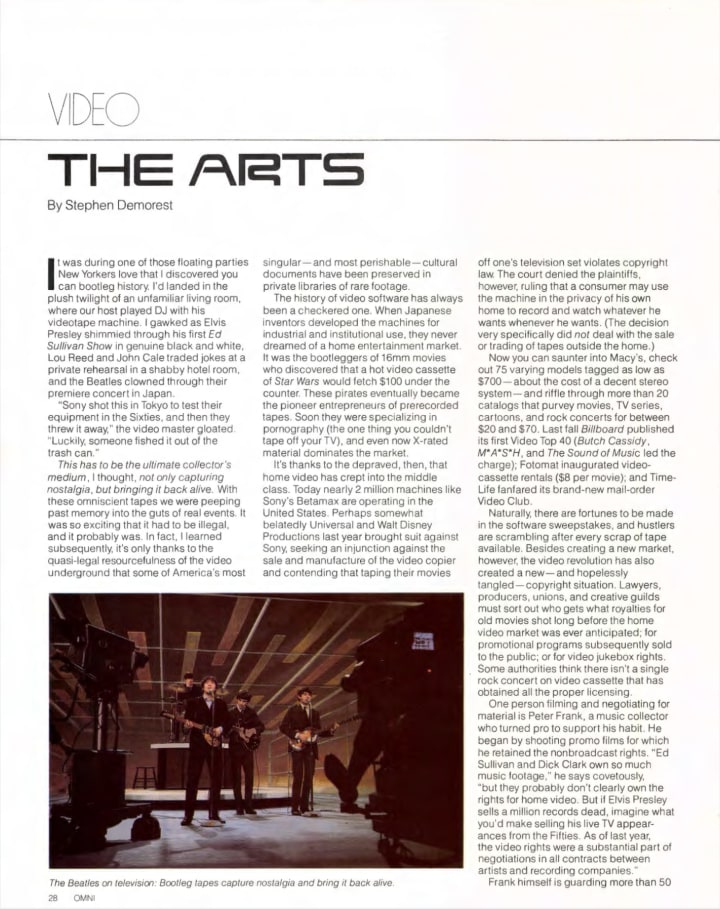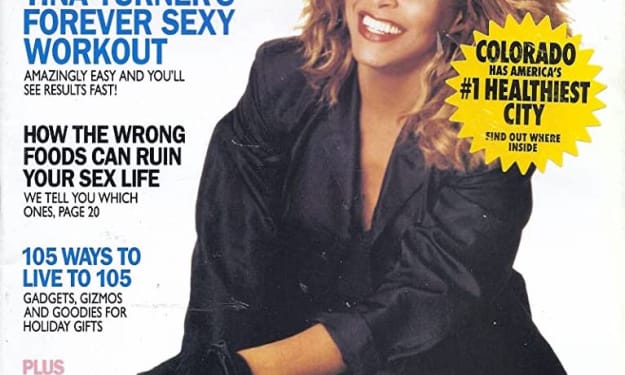From Lou Reed to M*A*S*H: The Status of Bootlegs in 1980
An excerpt from Omni Magazine provides rich context for fan-replicated media that is still shared through backchannels today.

The current era of bootleg media includes illegal recordings of Broadway shows shared through Google Drive, feature films leaked while in theaters due to early streaming dates, and a seemingly impossible amount of times Lana Del Rey has had her laptop stolen. There is a thoroughline from these stories into the past, as fans have secretly shared prized recordings throughout many iterations of media.
In the August 1980 issue of Omni, Stephen Demorest provides a survey of the bootleg landscape at the start of the 80s. The run-through includes questions regarding the nascent legal dealings with formats that allow for copying of audiovisual content, as well as references to many prized videos that might not have made it to YouTube.
"The Arts: Video" by Stephen Demorest, Omni Magazine, August 1980.*
*The remainder of this article was written by Stephen Demorest.

It was during one of those floating parties New Yorkers love that I discovered you can bootleg history. I'd landed in the plush twilight of an unfamiliar living room, where our host played DJ with his videotape machine. I gawked as Elvis Presley shimmied through his first Ed Sullivan Show in genuine black and white, Lou Reed and John Cale traded jokes at a private rehearsal in a shabby hotel room, and the Beatles clowned through their premiere concert in Japan.
"Sony shot this in Tokyo to test their equipment in the Sixties, and then they threw it away," the video master gloated. "Luckily, someone fished it out of the trash can."
This has to be the ultimate collector's medium, I thought, not only capturing nostalgia, but bringing it back alive. With these omniscient tapes we were peeping past memory into the guts of real events. It was so exciting that it had to be illegal, and it probably was. In fact, I learned subsequently, it's only thanks to the quasi-legal resourcefulness of the video underground that some of America's most singular - and most perishable - cultural documents have been preserved in private libraries of rare footage.
The history of video software has always been a checkered one. When Japanese inventors developed the machines for industrial and institutional use, they never dreamed of a home entertainment market. It was the bootleggers of 16mm movies who discovered that a hot video cassette of Star Wars would fetch $100 under the counter. These pirates eventually became the pioneer entrepreneurs of prerecorded tapes. Soon they were specializing in pornography (the one thing you couldn't tape off your TV), and even now X-rated material dominates the market.
It's thanks to the depraved, then, that home video has crept into the middle class. Today nearly 2 million machines like Sony's Betamax are operating in the United States. Perhaps somewhat belatedly Universal and Walt Disney Productions last year brought suit against Sony, seeking an injunction against the sale and manufacture of the video copier and contending that taping their movies off one's television set violates copyright law. The court denied the plaintiffs, however, ruling that a consumer may use the machine in the privacy of his own home to record and watch whatever he wants whenever he wants. (The decision very specifically did not deal with the sale or trading of tapes outside the home.)
Now you can saunter into Macy's, check out 75 varying models tagged as low as $700 - about the cost of a decent stereo system - and riffle through more than 20 catalogs that purvey movies, TV series, cartoons, and rock concerts for between $20 and $70. Last fall Billboard published its first Video Top 40 (Butch Cassidy, M*A*S*H, and The Sound of Music led the charge); Fotomat inaugurated video- cassette rentals ($8 per movie); and Time Life fanfared its brand-new mail-order Video Club.
Naturally, there are fortunes to be made in the software sweepstakes, and hustlers are scrambling after every scrap of tape available. Besides creating a new market, however, the video revolution has also created a new - and hopelessly tangled - copyright situation. Lawyers, producers, unions, and creative guilds must sort out who gets what royalties for old movies shot long before the home video market was ever anticipated; for promotional programs subsequently sold to the public; or for video jukebox rights. Some authorities think there isn't a single rock concert on video cassette that has obtained all the proper licensing.
One person filming and negotiating for material is Peter Frank, a music collector who turned pro to support his habit. He began by shooting promo films for which he retained the nonbroadcast rights. "Ed Sullivan and Dick Clark own so much music footage," he says covetously, "but they probably don't clearly own the rights for home video. But if Elvis Presley sells a million records dead, imagine what you'd make selling his live TV appearances from the Fifties. As of last year, the video rights were a substantial part of negotiations in all contracts between artists and recording companies."
Frank himself is guarding more than 50 hours of tape under "hold harmless" agreements until he can clear the rights for distribution. The major film studios, too, are playing it cool, hoarding the classic films in their catalogs until a boom market develops.
Less cool, though, are the black marketeers who plunder current hits as well as unreleased old favorites. In legitimate circles, the average film is sold to pay TV about a year after its initial theatrical release. After another year it's shown on free network television, and then a licensed cassette will be sold sometime after that.
Bootleggers, however, usually flood the country with knockoffs of a first-run film within six weeks of its theatrical debut, and sometimes they'll even have a blockbuster on the street before it's released to the theaters. (Twentieth Century-Fox has considered marketing cassettes simul- taneously with its theatrical releases, but theater owners are up in arms against the idea.) Someone who wishes to ship abroad can make a fortune in the untapped overseas market, where the movie may not reach the movie houses for months, if at all.
The FBI agent in charge of investigations on the West Coast says enforcement is futile once a film is shown on pay TV. "They set the pie in the window for anybody to grab." So his main concern is stopping piracy during the initial theatrical release. Just about anyone can steal a print - a lab technician, a projectionist, a shipper - and make a video master in a few hours. The film industry estimates it loses hundreds of millions of dollars a year this way.
John Lollos, whose two-year-old Video Tape Network has a hit with the "Mr. Bill Show" from Saturday Night Live, admits that piracy is eroding his business. "A guy came in here once and tried to sell me Gone with the Wind, and I knew it didn't belong to him. I said, 'Look, aren't you afraid you'll be caught?' But he just laughed and said, 'Where are you gonna look?'"
The FBI has closed down several profiteers (making merchants more circumspect in the process), but the offense is classified as a misdemeanor, with penalties that rarely reach the $25,000 maximum for first offenders - mere operating expenses for the serious rip-off artists. (A bill to make movie piracy a felony is currently before Congress.)
Manufacturers are now designing tapes that can't be duplicated, marking individual frames of films, adding what they call copy guards, and experimenting with signal scramblers. The movie companies are also trying to improve their security with computer tracing systems that keep track of every reel they distribute. The ultimate squelch of the bootleggers, though, may be the imminent video disc, which, unlike audio records, will retail for less than even blank cassette tapes. Meanwhile, since many pirates use inferior tape that acts like sandpaper on a machine's video heads, it's generally safer to tape borrowed items yourself. Blank tapes, at $16 for six hours, account for about 85 percent of all cassette sales; so someone obviously is thinking for himself.
The real experts are the cognoscenti who collect and trade unmarketed foreign films, original edits, coming attractions, trailers, Japanese cartoon and robot shows, political footage, wild Fifties commercials, and Star Trek bloopers. Some go for souvenir clips, such as moon landings or papal visits. Others, such as magician Richard Robinson, who tapes illusionists, are building up personal reference libraries. "Most video cassettes you can buy aren't worth seeing," scoffs Robinson, who wrote the definitive Video Primer in 1974 before becoming disenchanted. "Who wants to see a close-up of Steven Stills's face for an hour?"
These collectors aren't hardened criminals; they're just a loose network of independent counterculturists with no appetite for the legal spaghetti. "It's the logical next step for the fanatic who has every Rolling Stones record cover," Frank confides. "There are monumental films you can't see, but if you want them badly enough, somehow you'll manage."
True videophiles ferret out vintage tapes like knights hot on the trail of the Holy Grail. Frank, for instance, acquired nitty-gritty concert tapes from legendary radio jock Murray the K, and he regularly combs through small TV stations in Detroit, Cleveland, and Texas. "You try to find film editors, managers, or sponsors," he explains. "Before the era of big network broadcasts they used to carry copies of shows around to local stations, and you hope stuff will be found in a closet somewhere along the line."
Thanks to these unofficial video curators, vast amounts of Fifties television has been secured, pending copyright clearance. Also "around," if you know the right people, are such intimate exotica as the Rolling Stones' infamous Cocksucker Blues tour film and the legendary clip of Richard Nixon picking his nose just before reading his resignation speech.
Then there's mythical footage that's so rare even many insiders haven't seen it: Elvis on the Tommy and Jimmy Dorsey show in 1953; Louis Armstrong in Sweden in 1929; Stevie Wonder at the Apollo Theater as a child. Some say there's a 35mm film of the Beatles in India with the maharishi, but no one seems to know who shot it or where it is now. Others whisper that former Beatles manager Allen Klein has a terrific library stashed away. But it's also said you can't see it, which leads Frank to grouse, "It's like having part of your culture locked up in someone else's basement."
The ultimate frustrations are events carelessly "lost" down the oubliette of time. Many TV stations are less respectful of entertainment footage than of hard news, and they regularly destroy it every seven years. Rumor has it there was once a film of Buddy Holly's last performance before he boarded the airplane in which he lost his life. "Some people say that film still exists," Frank sighs, "but I believe it's probably gone." What about Bob Dylan's first electric concert at Newport? "It doesn't exist. Dylan is one of those artists you really want to have, but don't. But who knows? Stuff surfaces."
So the hunt for those once-in-a-lifetime tapes continues. Frank is particularly proud of some old news footage taken in New Orleans of funerals of great black Basin Street musicians. "It's so pure you could die from it," he gushes, "and it's your culture. It's part of America. Paul Revere silver doesn't hold a candle to it."
About the Creator
OG Collection
Exploring the most significant and hidden stories of the 20th century through iconic magazines and the titan of publishing behind them.
Check out our AI OG sandbox - https://vocal.media/authors/og-ai
Reader insights
Outstanding
Excellent work. Looking forward to reading more!
Top insights
Easy to read and follow
Well-structured & engaging content
Heartfelt and relatable
The story invoked strong personal emotions
On-point and relevant
Writing reflected the title & theme







Comments (2)
There are record stores in Tokyo that sell nothing but bootlegs, and I could not believe the number of recordings out there (a lot of Pink Floyd from their first appearance in the early 70s). Thank you for this!
Great article. Very informative. Most internet users don't realize how long bootlegs have been around for so long. Life was made more interesting since the invention of the VCR.